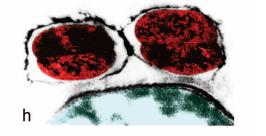Vampirococcus: Difference between revisions
No edit summary |
No edit summary |
||
| Line 22: | Line 22: | ||
Vampriococcus is one of few known predatory prokaryotes. It is a 0.6 micrometer, ovidal bacteria of which no modal forms have been found. It is a gram-negative bacteria that is found in freshwater sulfurous lakes in northern Spain. As an anaerobic epibiont, it attaches itself to the surface of Chromatium a phototropic bacteria, by specific structures, and as it grows and devides by fission, it destroys its prey [2]. The structures used by Vampirococcus to attach itself to its prey could best be described as cytoplasmic "bridges." From these bridges, a connection is established to the prey which allows the Vampirococcus bacterium to degrade the preys cytoplasm [4] | Vampriococcus is one of few known predatory prokaryotes. It is a 0.6 micrometer, ovidal bacteria of which no modal forms have been found. It is a gram-negative bacteria that is found in freshwater sulfurous lakes in northern Spain. As an anaerobic epibiont, it attaches itself to the surface of Chromatium a phototropic bacteria, by specific structures, and as it grows and devides by fission, it destroys its prey [2]. The structures used by Vampirococcus to attach itself to its prey could best be described as cytoplasmic "bridges." From these bridges, a connection is established to the prey which allows the Vampirococcus bacterium to degrade the preys cytoplasm [4] | ||
==Genomic Structure== | |||
"Phylogenetic Analysis of Vampirococcus and Daptobacter has yet to be undertaken (as they have not yet been grown in culture)" [1]. The article goes on to say that Vampirococcus may be related to Deltaproterbacteria and Bdellovibro due to the manor of their growth. | |||
==Sources== | ==Sources== | ||
Revision as of 23:50, 1 February 2012
Classification
Higher order taxa
Kingdom: Prokaryotae
- Domain: Bacteria
- Phylum: Unknown
- Class: Unknown
- Order: Unknown
- Family: Unknown
- Order: Unknown
- Class: Unknown
- Phylum: Unknown
As of 2008, "Phylogenetic Analysis of Vampirococcus and Daptobacter has yet to be undertaken...[1]"
Species
- Genus: Vampirococcus
- Species: Unknown
Description and significance
Vampriococcus is one of few known predatory prokaryotes. It is a 0.6 micrometer, ovidal bacteria of which no modal forms have been found. It is a gram-negative bacteria that is found in freshwater sulfurous lakes in northern Spain. As an anaerobic epibiont, it attaches itself to the surface of Chromatium a phototropic bacteria, by specific structures, and as it grows and devides by fission, it destroys its prey [2]. The structures used by Vampirococcus to attach itself to its prey could best be described as cytoplasmic "bridges." From these bridges, a connection is established to the prey which allows the Vampirococcus bacterium to degrade the preys cytoplasm [4]
Genomic Structure
"Phylogenetic Analysis of Vampirococcus and Daptobacter has yet to be undertaken (as they have not yet been grown in culture)" [1]. The article goes on to say that Vampirococcus may be related to Deltaproterbacteria and Bdellovibro due to the manor of their growth.
Sources
[1] Whitworth, David E. "Myxobacteria [electronic resource] : multicellularity and differentiation" Washington, DC : ASM Press, c2008.
[2] Ricardo Guerrero,Carlos Pedros-Alio Et al. Predatory prokaryotes: Predation and primary consumption evolved in bacteria, Evolution and Microbiology, Vol. 83, pp. 2138-2142, April 1986
[3] Edouard Jurkevitch,Predatory Behaviors in Bacteria—Diversity and Transitions, Microbe Volume 2, Number 2, 2007
[4] Martin, Mark O. Journal of Molecular Microbiology and Biotechnology. Predatory Prokaryotes: An Emerging Research Opportunity, Vol. 4, Issue 5, pp. 467–477, 2002

